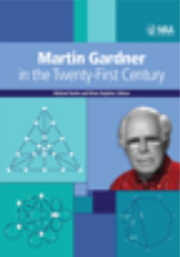Book contents
- Frontmatter
- Preface
- Contents
- I Geometry
- II Number Theory and Graph Theory
- III Flexagons and Catalan Numbers
- 12 It's Okay to Be Square If You're a Flexagon
- 13 The V-flex, Triangle Orientation, and Catalan Numbers in Hexaflexagons
- 14 From Hexaflexagons to Edge Flexagons to Point Flexagons
- 15 Flexagons Lead to a Catalan Number Identity
- 16 Convergence of a Catalan Series
- IV Making Things Fit
- V Further Puzzles and Games
- VI Cards and Probability
- VII Other Aspects of Martin Gardner
- Index
- About the Editors
13 - The V-flex, Triangle Orientation, and Catalan Numbers in Hexaflexagons
from III - Flexagons and Catalan Numbers
- Frontmatter
- Preface
- Contents
- I Geometry
- II Number Theory and Graph Theory
- III Flexagons and Catalan Numbers
- 12 It's Okay to Be Square If You're a Flexagon
- 13 The V-flex, Triangle Orientation, and Catalan Numbers in Hexaflexagons
- 14 From Hexaflexagons to Edge Flexagons to Point Flexagons
- 15 Flexagons Lead to a Catalan Number Identity
- 16 Convergence of a Catalan Series
- IV Making Things Fit
- V Further Puzzles and Games
- VI Cards and Probability
- VII Other Aspects of Martin Gardner
- Index
- About the Editors
Summary
Using only the pinch flex, the flex described by Martin Gardner in [4], the six triangles of each hexagonal face of a hexaflexagon stay together. If the faces are colored, the face facing up is always monochrome. To scramble the triangles and mix the colors, you need other flexes. In this paper, we describe the V-flex. With the V-flex, faces become multi-colored when flexed. It takes persistence to master, but the V-flex is worth it. A hexahexaflexagon has only 9 mathematical faces under the pinch flex; with the V-flex it has 3,420.
We conjecture that many people performed a V-flex accidentally as they read Martin Gardner's 1956 article and had no expert help. In 1963, Bruce McLean discovered the V-flex and, in 1978, provided a graph of the faces. He presented it to Arthur Stone at an MAA meeting that year and was told “I never allowed my students to do that!” In that paper, McLean approached the V-flex systematically as a new flex. The view that the V- flex is somehow wrong, however, persists to the present. In 2011, a referee of this paper wrote, “I've taken the majority view, that it was an illegal move and that my only purpose in understanding it was to fix ‘broken’ flexagons.” The V-flex is now understood as a well-defined operation (see [8] for an overview) that adds considerable complexity to an already interesting object.
Information
- Type
- Chapter
- Information
- Martin Gardner in the Twenty-First Century , pp. 103 - 108Publisher: Mathematical Association of AmericaPrint publication year: 2012
